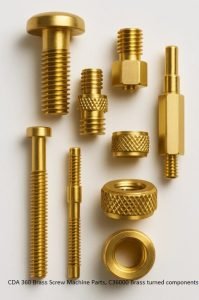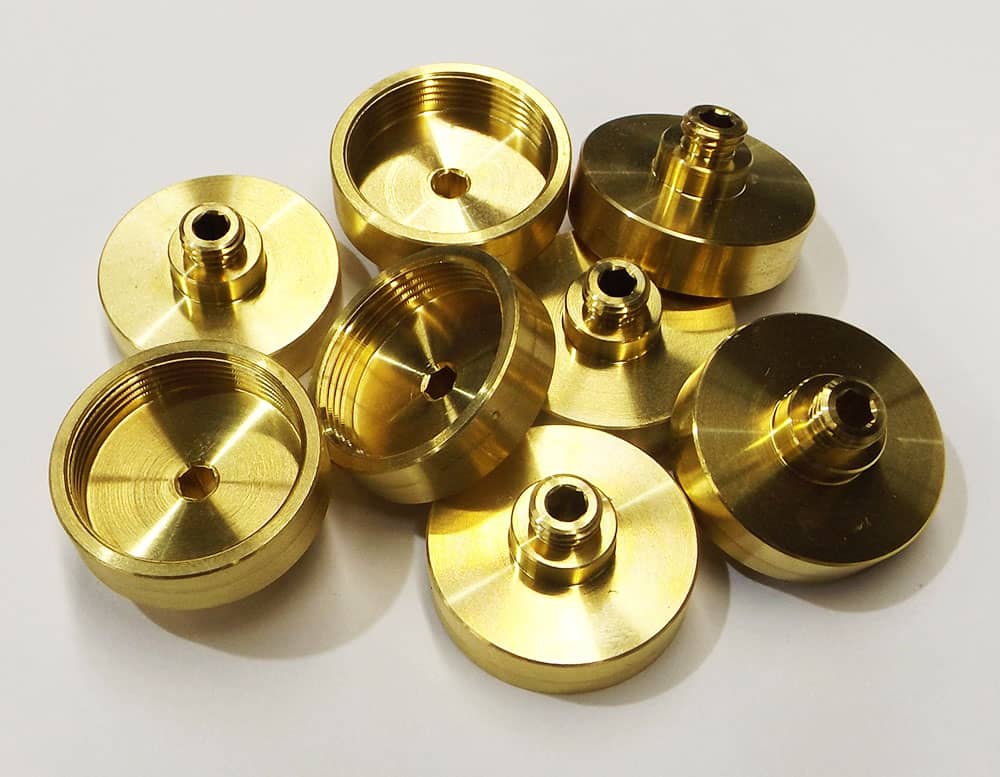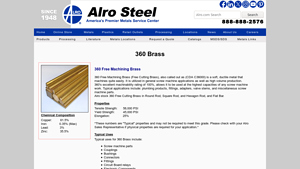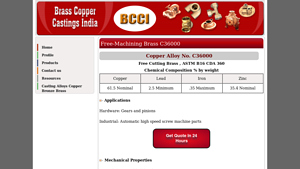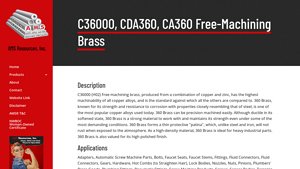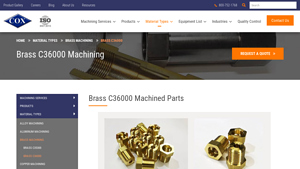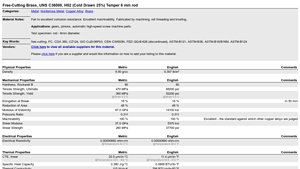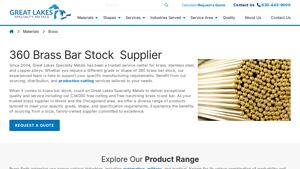Cda 360 Brass Guide: Type, Cost, Top List…
Introduction: Navigating the Global Market for cda 360 brass
In today’s competitive global market, sourcing high-quality CDA 360 brass can be a daunting challenge for B2B buyers, particularly those in regions like Africa, South America, the Middle East, and Europe. As the demand for this versatile alloy rises due to its exceptional machinability and corrosion resistance, navigating the complexities of supply chains and supplier capabilities becomes critical. This guide aims to empower international buyers by providing a comprehensive overview of CDA 360 brass, including its various types, applications, and mechanical properties, as well as actionable insights on supplier vetting and cost considerations.
CDA 360 brass, known for its superior machinability rating and suitability for high-speed machining operations, is widely used in manufacturing sectors ranging from plumbing fittings to electronic components. Understanding the specific applications and characteristics of this alloy is essential for making informed purchasing decisions. This guide not only explores the technical specifications and industry standards associated with CDA 360 brass but also highlights best practices for evaluating suppliers to ensure quality and reliability.
By leveraging the insights provided in this guide, B2B buyers will be better equipped to navigate the global market for CDA 360 brass, ultimately enhancing their procurement strategies and driving operational efficiency. Whether you are looking to enhance your supply chain or ensure compliance with international standards, this resource will serve as a valuable tool in your decision-making process.
Understanding cda 360 brass Types and Variations
| Type Name | Key Distinguishing Features | Primary B2B Applications | Brief Pros & Cons for Buyers |
|---|---|---|---|
| C36000 Free-Cutting Brass | Highest machinability rating (100), excellent corrosion resistance | Automatic screw machine parts, plumbing fittings, gears | Pros: Exceptional machining speed; Cons: Limited hot forming capabilities |
| C36000 H02 Brass | Half-hard temper providing moderate strength | Valves, valve stems, pneumatic fittings | Pros: Good strength for precision parts; Cons: Not suitable for welding |
| C36000 H04 Brass | Full-hard temper offering maximum strength | Heavy-duty components, high-stress applications | Pros: Superior strength; Cons: Reduced machinability compared to softer variants |
| C36000 Leaded Brass | Contains lead for enhanced machinability | Electrical connectors, fasteners, and fittings | Pros: Superior machining; Cons: Environmental regulations may restrict use |
| C36000 Eco Brass | Low lead content compliant with safety regulations | Plumbing components, potable water systems | Pros: Environmentally friendly; Cons: Slightly lower machinability than leaded variants |
What Are the Key Characteristics of C36000 Free-Cutting Brass?
C36000 Free-Cutting Brass is renowned for its exceptional machinability, rated at 100, making it the benchmark for all copper alloys. This alloy is composed mainly of copper and zinc, providing excellent corrosion resistance and a polished finish. Its primary applications include automatic screw machine parts and plumbing fittings, where high-speed machining is essential. Buyers should consider its limited hot forming capabilities, which may affect certain manufacturing processes.
How Does C36000 H02 Brass Differ from Other Variants?
C36000 H02 Brass features a half-hard temper that strikes a balance between strength and ductility. It is suitable for precision applications like valves and pneumatic fittings, where moderate strength is required without sacrificing machinability. This variant is easy to solder and braze, making it a versatile choice for many engineering projects. However, its inability to be welded may limit its use in some applications.
What Advantages Does C36000 H04 Brass Offer?
C36000 H04 Brass, with its full-hard temper, provides maximum strength, making it ideal for heavy-duty components and high-stress applications. Although it excels in strength, it has reduced machinability compared to softer variants, which may lead to longer production times. Buyers should evaluate the trade-off between strength and ease of machining based on their specific project requirements.
Why Choose C36000 Leaded Brass?
C36000 Leaded Brass incorporates lead to enhance its machinability, making it a preferred choice for electrical connectors and fasteners. While it offers superior machining capabilities, buyers must navigate the environmental regulations surrounding lead content, which may limit its use in certain applications. This variant is ideal for projects where precision and speed are critical, but buyers should ensure compliance with relevant safety standards.
What Makes C36000 Eco Brass a Sustainable Option?
C36000 Eco Brass is formulated with low lead content, meeting modern safety regulations while maintaining good machinability. This variant is particularly suited for plumbing components and potable water systems, where environmental considerations are paramount. While it may have slightly lower machinability compared to leaded brass, its compliance with safety standards makes it an attractive option for environmentally conscious buyers looking to balance performance with sustainability.
Key Industrial Applications of cda 360 brass
| Industry/Sector | Specific Application of cda 360 brass | Value/Benefit for the Business | Key Sourcing Considerations for this Application |
|---|---|---|---|
| Plumbing & HVAC | Faucet Components and Plumbing Fittings | High corrosion resistance ensures longevity and reliability. | Compliance with local regulations on lead content and quality standards. |
| Automotive & Aerospace | Pneumatic Fittings and Valve Components | Excellent machinability allows for precise, high-speed production. | Need for certifications (e.g., ASTM, SAE) and performance testing. |
| Electrical & Electronics | Circuit Board Relays and Connectors | Provides reliable conductivity and durability in electronic applications. | Availability of lead-free options and adherence to RoHS standards. |
| Heavy Machinery | Gears and Pinions | High strength and wear resistance improve operational efficiency. | Sourcing from reputable suppliers to ensure material integrity and performance. |
| Musical Instruments | Brass Components for Instruments | Provides a desirable aesthetic finish and acoustic properties. | Consideration of material grade and finish for specific instrument types. |
How is cda 360 brass utilized in Plumbing and HVAC sectors?
In the plumbing and HVAC industries, cda 360 brass is commonly used for faucet components and plumbing fittings. Its excellent corrosion resistance extends the lifespan of fixtures and ensures that they remain functional under various environmental conditions. For international buyers, particularly in regions like Africa and South America, sourcing cda 360 brass that complies with local regulations regarding lead content is crucial to ensure safety and quality in water systems.
What are the applications of cda 360 brass in Automotive and Aerospace?
Cda 360 brass finds significant use in pneumatic fittings and valve components within the automotive and aerospace sectors. Its superior machinability allows manufacturers to produce complex parts quickly and precisely, reducing production costs and time. Buyers from the Middle East and Europe should prioritize suppliers who can provide certifications such as ASTM and SAE to ensure compliance with industry standards and safety regulations.
How does cda 360 brass benefit the Electrical and Electronics industry?
In the electrical and electronics industry, cda 360 brass is utilized for circuit board relays and connectors due to its reliable conductivity and mechanical strength. This alloy’s durability ensures that components can withstand the rigors of high-performance applications. International buyers should look for lead-free options that comply with RoHS standards, especially in regions with strict environmental regulations, such as Europe.
What role does cda 360 brass play in Heavy Machinery?
Cda 360 brass is integral to the production of gears and pinions in heavy machinery due to its high strength and wear resistance. These properties enhance the operational efficiency and durability of machinery components, which is vital in demanding industrial environments. Buyers should ensure that their suppliers offer high-quality materials to meet the rigorous performance requirements in various heavy-duty applications.
How is cda 360 brass used in Musical Instruments?
Cda 360 brass is favored in the manufacturing of brass components for musical instruments, providing both aesthetic appeal and desirable acoustic properties. Its high polish finish enhances the visual quality of the instruments, making them more attractive to consumers. For buyers, understanding the specific material grades and finishes required for different types of instruments is essential to ensure optimal sound quality and performance.
3 Common User Pain Points for ‘cda 360 brass’ & Their Solutions
Scenario 1: High Machining Costs Impacting Profit Margins
The Problem: A manufacturing company is facing escalating costs in machining components made from brass due to inefficient processes and material choices. The high-speed machining of components is critical for productivity, but the current materials used are not performing well, leading to increased tool wear and longer processing times. This results in higher operational costs and reduced profit margins, making it difficult to compete in the global market.
The Solution: To address this challenge, B2B buyers should consider switching to CDA 360 brass, known for its exceptional machinability and efficiency. By sourcing CDA 360 brass, which boasts a machinability rating of 100, companies can reduce tool wear significantly and improve processing speeds. It is essential to work closely with suppliers to ensure the brass is sourced from reputable manufacturers who adhere to ASTM specifications. Additionally, investing in the right machining tools optimized for brass can further enhance efficiency. Conducting trial runs with CDA 360 brass in various machining applications can help identify the optimal settings and processes, ultimately reducing costs and improving profit margins.
Scenario 2: Concerns Over Corrosion Resistance in Harsh Environments
The Problem: An engineering firm is tasked with supplying components for marine applications, where exposure to saltwater and humidity poses significant risks of corrosion. The firm’s existing brass suppliers provide materials that do not withstand these harsh conditions, leading to frequent failures and warranty claims. This not only affects customer satisfaction but also increases replacement costs and project delays.
The Solution: To mitigate corrosion-related issues, B2B buyers should prioritize CDA 360 brass due to its superior corrosion resistance compared to other alloys. This brass forms a protective patina that prevents rusting, making it suitable for marine applications. When specifying materials for projects, it is crucial to communicate the environmental conditions the components will face. Collaborating with suppliers to conduct corrosion testing can provide valuable data on the material’s performance under specific conditions. Additionally, implementing preventive measures such as applying protective coatings or finishes can enhance the longevity of components in corrosive environments.
Scenario 3: Compliance with Regulatory Standards for Drinking Water Applications
The Problem: A plumbing parts manufacturer is struggling to meet stringent regulatory requirements for potable water applications. Recent changes in legislation regarding lead content in materials have prompted a thorough review of their supply chain, and many existing brass suppliers do not comply with the new standards. This situation poses a risk of penalties and could damage the company’s reputation if non-compliant products are inadvertently used.
The Solution: B2B buyers must ensure they are sourcing CDA 360 brass that complies with the latest regulations concerning lead content, particularly for drinking water applications. It is vital to engage with suppliers who provide certifications and documentation confirming their materials meet relevant standards, such as the Safe Drinking Water Act. Establishing a robust quality assurance process that includes regular audits and compliance checks can help mitigate risks. Additionally, participating in industry associations can provide insights into regulatory changes and best practices for sourcing compliant materials. By prioritizing compliance, manufacturers can safeguard their operations and maintain customer trust.
Strategic Material Selection Guide for cda 360 brass
What Are the Key Properties of CDA 360 Brass?
CDA 360 brass, also known as C36000 or free-cutting brass, is renowned for its exceptional machinability, rated at 100%, making it the benchmark for all copper alloys. This alloy typically comprises around 61.5% copper and 35.5% zinc, with trace amounts of lead. Its mechanical properties include a tensile strength of approximately 58,000 PSI and a yield strength of 45,000 PSI, which contribute to its robustness in various applications. CDA 360 brass also exhibits good corrosion resistance, forming a protective patina that prevents rusting, unlike steel or iron.
What Are the Advantages and Disadvantages of Using CDA 360 Brass?
Advantages:
CDA 360 brass is particularly advantageous for high-speed machining operations, allowing for increased productivity and reduced manufacturing costs. Its excellent thread rolling and knurling characteristics make it suitable for precision components such as fittings, valves, and gears. Additionally, it can be easily soldered or brazed, enhancing its versatility in assembly processes.
Disadvantages:
However, CDA 360 brass has limitations. Its cold forming capabilities are poor, and it is not recommended for welding, which may restrict its use in certain applications. The alloy’s cost can also be higher compared to alternative materials like steel, especially when considering the price fluctuations in copper and zinc markets.
How Does CDA 360 Brass Impact Specific Applications?
CDA 360 brass is widely used in applications that require high durability and precise machining, including plumbing fittings, pneumatic components, and automatic screw machine parts. Its compatibility with various media, including water and gases, makes it ideal for fluid connectors and valve stems. However, buyers must consider the specific environmental conditions and potential corrosive elements in their applications, as these can impact the alloy’s performance.
What Should International B2B Buyers Consider When Selecting CDA 360 Brass?
International buyers, particularly from Africa, South America, the Middle East, and Europe, should be aware of compliance with local and international standards such as ASTM, DIN, and JIS. Regulations regarding lead content in plumbing applications are particularly stringent in Europe and North America, necessitating careful selection of materials. Additionally, understanding the local market dynamics and supply chain logistics is crucial for cost-effective procurement.
| Material | Typical Use Case for CDA 360 Brass | Key Advantage | Key Disadvantage/Limitation | Relative Cost (Low/Med/High) |
|---|---|---|---|---|
| CDA 360 Brass | Plumbing fittings | Exceptional machinability | Poor cold forming capabilities | Medium |
| CDA 360 Brass | Pneumatic components | Excellent corrosion resistance | Not suitable for welding | Medium |
| CDA 360 Brass | Automatic screw machine parts | High-speed machining efficiency | Higher cost compared to steel | Medium |
| CDA 360 Brass | Valve stems | Versatile for soldering and brazing | Limited hot forming capabilities | Medium |
In summary, CDA 360 brass is a versatile and high-performance material suitable for a range of applications. However, international buyers must navigate compliance and cost considerations to optimize their sourcing strategies.
In-depth Look: Manufacturing Processes and Quality Assurance for cda 360 brass
What Are the Key Stages in the Manufacturing Process of CDA 360 Brass?
The manufacturing process of CDA 360 brass involves several critical stages that ensure the material meets high-quality standards suitable for various applications.
Material Preparation: What is the Importance of Raw Material Selection?
The first stage in the manufacturing of CDA 360 brass is the selection of raw materials, primarily copper and zinc, which are sourced from reliable suppliers. The quality of these raw materials significantly influences the final product’s properties, including strength, corrosion resistance, and machinability. The copper typically comprises around 61.5%, while zinc accounts for about 35.5%. Any impurities, particularly lead, are closely monitored as they can affect the machinability and overall quality of the brass.
Forming: Which Techniques Are Commonly Used?
Once the raw materials are prepared, they undergo forming processes, which may include extrusion, forging, or casting. Extrusion is particularly favored for producing rods, bars, and other shapes due to its efficiency in achieving the desired dimensions and mechanical properties. During this stage, the material is heated to a specific temperature range (1300°F to 1450°F) to enhance its workability.
Machining is a critical part of the forming process, especially for CDA 360 brass, which is known for its exceptional machinability rating of 100. Techniques such as turning, milling, and drilling are applied to create precise components like valve stems and fittings. The ability to perform high-speed machining operations not only reduces production time but also enhances the accuracy of the final products.
Assembly: What Does the Assembly Stage Entail?
After forming, various components may need to be assembled. This can involve soldering or brazing, as CDA 360 brass excels in these joining methods. However, it is important to note that oxyacetylene welding is generally not recommended due to the material’s properties. Ensuring proper assembly techniques are applied is crucial, as improper joining can lead to failures in high-pressure applications.
Finishing: How Is the Final Product Prepared for Market?
The final stage is finishing, which may include processes such as polishing, plating, or coating. These processes not only improve the aesthetic appearance of the brass but also enhance its corrosion resistance. For B2B buyers, understanding the finishing processes is vital, especially when the brass components will be used in environments where corrosion could significantly impact performance.
How is Quality Assurance Implemented in the Manufacturing of CDA 360 Brass?
Quality assurance is a critical aspect of the manufacturing process for CDA 360 brass, ensuring that the final products meet both international standards and customer specifications.
What International Standards Apply to CDA 360 Brass Manufacturing?
CDA 360 brass manufacturing is often governed by several international standards, including ISO 9001, which outlines the criteria for a quality management system. Adhering to these standards helps manufacturers maintain consistency and quality in their production processes. Additionally, industry-specific standards such as CE (Conformité Européenne) and API (American Petroleum Institute) may apply, particularly for products intended for use in specific applications like plumbing and oil & gas.
What Are the Key Quality Control Checkpoints?
Quality control (QC) checkpoints are integrated throughout the manufacturing process, including:
-
Incoming Quality Control (IQC): This initial stage involves inspecting raw materials upon arrival to ensure they meet specified requirements. Materials that do not meet standards are rejected.
-
In-Process Quality Control (IPQC): During the manufacturing process, various parameters such as temperature, pressure, and dimensional accuracy are monitored. This proactive approach helps identify and rectify potential issues before they escalate.
-
Final Quality Control (FQC): Once the components are completed, they undergo rigorous testing to ensure they meet the required specifications. This includes dimensional checks, mechanical property tests, and corrosion resistance evaluations.
What Common Testing Methods Are Utilized?
To verify the quality of CDA 360 brass, several testing methods are employed:
- Tensile Testing: Measures the material’s strength and ductility.
- Hardness Testing: Assesses the hardness level, which is crucial for applications involving wear.
- Corrosion Testing: Evaluates the material’s resistance to environmental factors that may lead to degradation.
- Dimensional Inspection: Ensures that all components meet the required tolerances.
How Can B2B Buyers Verify Supplier Quality Control?
For B2B buyers, particularly those in regions like Africa, South America, the Middle East, and Europe, verifying a supplier’s quality control processes is essential for ensuring the reliability of CDA 360 brass products.
What Steps Can Buyers Take for Supplier Verification?
-
Conduct Audits: Regular audits of suppliers can provide insight into their quality management systems. This includes reviewing their adherence to international standards and internal QC processes.
-
Request Quality Reports: Buyers should request documentation that outlines the results of quality tests performed on the products. This may include certificates of conformity, test reports, and material certifications.
-
Engage Third-Party Inspectors: Utilizing independent third-party inspectors can provide an objective assessment of the supplier’s manufacturing and QC processes. This adds an extra layer of assurance for buyers.
What Are the QC Nuances for International B2B Buyers?
International B2B buyers must navigate specific nuances related to quality control that may vary by region:
-
Regulatory Compliance: Different countries have varying regulations regarding the use of brass in applications such as plumbing and food processing. Understanding these regulations is crucial for ensuring compliance.
-
Cultural Differences: Variations in business practices and communication styles can impact the effectiveness of quality assurance measures. Building strong relationships with suppliers can help bridge these gaps.
-
Logistical Considerations: The transportation of materials and finished products across borders may introduce additional quality risks. Implementing stringent QC measures throughout the supply chain can mitigate these risks.
By understanding the manufacturing processes and quality assurance measures associated with CDA 360 brass, B2B buyers can make informed decisions and ensure they source high-quality products that meet their specific needs.
Practical Sourcing Guide: A Step-by-Step Checklist for ‘cda 360 brass’
To assist B2B buyers in effectively sourcing CDA 360 brass, this guide provides a structured checklist to streamline the procurement process. CDA 360 brass, known for its superior machinability and corrosion resistance, is widely used across various industries, making it essential for buyers to approach sourcing with a clear strategy.
Step 1: Define Your Technical Specifications
Before initiating the sourcing process, establish clear technical specifications for the CDA 360 brass you require. This includes dimensions, hardness, and mechanical properties that align with your project needs. Understanding these specifications will help you communicate effectively with suppliers and ensure the materials meet your performance requirements.
Step 2: Research Potential Suppliers
Conduct thorough research to identify potential suppliers of CDA 360 brass. Utilize online directories, industry-specific platforms, and trade shows to compile a list of manufacturers. Look for companies with a proven track record in producing brass components, and assess their reputation through reviews and testimonials.
Step 3: Evaluate Supplier Certifications
Verify that potential suppliers possess the necessary certifications and compliance with international standards such as ASTM B16 or SAE J461. Certifications indicate adherence to quality and safety standards, which is crucial when sourcing materials for critical applications. Request documentation to confirm their compliance and assess their quality control processes.
Step 4: Request Samples for Testing
Before placing a bulk order, request samples of the CDA 360 brass. Testing samples allows you to evaluate the material’s properties, such as machinability and corrosion resistance, against your specifications. This step minimizes risks associated with quality issues and ensures that the brass will perform as required in your applications.
Step 5: Assess Pricing and Payment Terms
Compare pricing from different suppliers while considering the total cost of ownership, which includes shipping, customs duties, and potential tariffs. Additionally, negotiate payment terms that align with your budget and cash flow. Understanding the financial aspects upfront can help in making informed purchasing decisions.
Step 6: Inquire About Lead Times and Delivery Options
Discuss lead times and delivery options with your shortlisted suppliers. Understanding their production capabilities and shipping timelines is essential to align with your project schedules. Ensure that they can accommodate your delivery requirements to avoid delays in your production processes.
Step 7: Establish a Communication Plan
Once you select a supplier, establish a clear communication plan. Define points of contact and preferred methods of communication to facilitate smooth interactions. Regular updates regarding order status, potential issues, and other critical information can enhance the supplier relationship and ensure timely deliveries.
By following this step-by-step checklist, B2B buyers can effectively navigate the complexities of sourcing CDA 360 brass, ensuring they select the right materials and suppliers to meet their operational needs.
Comprehensive Cost and Pricing Analysis for cda 360 brass Sourcing
What Are the Key Cost Components in Sourcing CDA 360 Brass?
When sourcing CDA 360 brass, understanding the cost structure is essential for effective budgeting and pricing negotiations. The primary cost components include materials, labor, manufacturing overhead, tooling, quality control (QC), logistics, and profit margins.
-
Materials: The base material cost for CDA 360 brass, primarily composed of copper and zinc, can fluctuate based on global copper prices. Buyers should monitor market trends and negotiate prices based on current rates.
-
Labor: Labor costs vary significantly by region and can influence overall pricing. Skilled labor is essential for high-speed machining operations, which CDA 360 brass is known for. Countries with lower labor costs may offer competitive pricing but assess the quality of workmanship carefully.
-
Manufacturing Overhead: This includes costs associated with factory operations, utilities, and administrative expenses. Efficient production processes can reduce overhead, impacting the final price of the brass products.
-
Tooling: Tooling costs are pertinent for custom orders and specific applications. High-quality tooling is necessary for precision machining of CDA 360 brass, which can lead to higher upfront costs but lower long-term costs due to reduced waste and rework.
-
Quality Control (QC): Investing in QC ensures that the brass meets necessary specifications and standards. This can add to the cost but is crucial for preventing defects that could lead to expensive recalls or rejections.
-
Logistics: Shipping and handling costs can vary based on the distance from the supplier, mode of transport, and Incoterms used. International buyers should consider these factors as they can significantly impact the total cost.
-
Margin: Suppliers typically include a profit margin in their pricing, which can vary widely based on competition, demand, and market conditions.
How Do Price Influencers Affect CDA 360 Brass Sourcing?
Several factors can influence the pricing of CDA 360 brass, especially for international B2B buyers:
-
Volume/MOQ: Suppliers often offer discounts based on order volume. Buyers should consider their needs carefully and negotiate minimum order quantities (MOQ) to achieve better pricing.
-
Specifications and Customization: Custom specifications may lead to additional costs. Buyers should define their requirements clearly and understand how these will impact pricing.
-
Quality and Certifications: Brass quality and compliance with international standards can influence costs. Certifications can add value but may also increase the price.
-
Supplier Factors: The reputation and reliability of the supplier can affect pricing. Established suppliers may charge a premium for their experience and quality assurance.
-
Incoterms: Understanding Incoterms is vital for international transactions. They dictate the responsibilities of buyers and sellers regarding shipping, insurance, and tariffs, which can affect overall costs.
What Are Some Negotiation Tips for International Buyers?
For B2B buyers, especially from regions like Africa, South America, the Middle East, and Europe, effective negotiation can lead to significant savings:
-
Understand Total Cost of Ownership (TCO): Consider not just the purchase price but all costs associated with the product over its lifecycle, including maintenance and disposal.
-
Leverage Relationships: Building long-term relationships with suppliers can lead to better pricing and favorable terms. Trust can be a powerful negotiation tool.
-
Be Informed: Stay updated on market conditions, material costs, and competitor pricing. This knowledge empowers buyers during negotiations.
-
Explore Alternative Suppliers: Don’t hesitate to seek quotes from multiple suppliers. This can provide leverage in negotiations and may uncover better pricing options.
-
Consider Local Suppliers: In some cases, sourcing locally can reduce shipping costs and import duties, making it a more cost-effective option.
Disclaimer on Pricing
Prices for CDA 360 brass can fluctuate based on market conditions, supplier pricing strategies, and material costs. Buyers are encouraged to obtain multiple quotes and conduct thorough due diligence to secure the best possible pricing.
Alternatives Analysis: Comparing cda 360 brass With Other Solutions
Introduction to Alternatives for Cda 360 Brass
When considering materials for manufacturing and engineering applications, it is essential to evaluate various options to determine the best fit for specific needs. Cda 360 brass, known for its exceptional machinability and corrosion resistance, stands out in many applications. However, alternatives such as stainless steel, aluminum alloys, and other brass formulations may also provide viable solutions depending on the context. This section compares Cda 360 brass with these alternatives to help B2B buyers make informed decisions.
Comparison Table
| Comparison Aspect | Cda 360 Brass | Stainless Steel | Aluminum Alloys |
|---|---|---|---|
| Performance | High machinability, good corrosion resistance | Excellent strength, corrosion resistance | Lightweight, good machinability |
| Cost | Moderate cost | Generally higher cost | Lower cost than brass and steel |
| Ease of Implementation | Easy to machine and fabricate | Requires specialized tools | Easily machinable, versatile |
| Maintenance | Low maintenance due to corrosion resistance | Low maintenance but can corrode in certain environments | Requires protective coatings for longevity |
| Best Use Case | Precision components, plumbing parts | Structural applications, automotive | Aerospace, consumer goods |
Detailed Breakdown of Alternatives
1. Stainless Steel
Stainless steel is a popular alternative known for its exceptional strength and resistance to corrosion. It is especially advantageous in applications requiring durability and longevity, such as structural components and automotive parts. However, the cost of stainless steel is generally higher than Cda 360 brass, and its machinability is not as favorable. Specialized tools are often necessary for effective machining, which can increase production costs and time. Nonetheless, for applications where strength is paramount, stainless steel may be the preferred choice.
2. Aluminum Alloys
Aluminum alloys are valued for their lightweight properties and good machinability, making them an attractive alternative to brass. They are often utilized in aerospace and consumer goods due to their favorable strength-to-weight ratio. Aluminum is generally more cost-effective than both Cda 360 brass and stainless steel, which can significantly reduce overall production expenses. However, aluminum alloys may require protective coatings to enhance corrosion resistance, particularly in harsh environments, which can add to maintenance considerations.
Conclusion: How to Choose the Right Solution
When selecting the appropriate material for specific applications, B2B buyers must consider various factors, including performance requirements, cost constraints, ease of implementation, and maintenance needs. Cda 360 brass excels in precision machining and corrosion resistance, making it ideal for components in plumbing and intricate machine parts. However, alternatives like stainless steel and aluminum alloys may be better suited for applications that prioritize strength or weight efficiency. Ultimately, the choice depends on the specific requirements of the project and the operational environment, ensuring that businesses invest in materials that align with their production goals and budgetary considerations.
Essential Technical Properties and Trade Terminology for cda 360 brass
What are the Key Technical Properties of CDA 360 Brass?
CDA 360 brass, also known as C36000 or free-cutting brass, is widely recognized for its exceptional machinability and strength. Understanding its technical specifications is crucial for B2B buyers to ensure they select the right materials for their manufacturing needs. Here are some of the essential properties:
-
Material Grade
CDA 360 brass is classified under ASTM B16 and SAE J461, which denote its compliance with specific industry standards. This classification is vital for international buyers to ensure that the material meets regional regulations and quality standards, particularly for applications in plumbing and electrical components. -
Machinability Rating
CDA 360 brass boasts a machinability rating of 100, making it the benchmark against which other copper alloys are compared. This high rating indicates that the material can be easily shaped and cut, reducing production time and costs. For manufacturers, this translates to higher efficiency and lower operational expenses. -
Mechanical Properties
Typical mechanical properties for CDA 360 include a tensile strength of approximately 58,000 PSI and a yield strength of about 45,000 PSI. These values are significant for B2B buyers as they indicate the material’s ability to withstand stress and strain in various applications, ensuring durability and reliability in end products. -
Corrosion Resistance
CDA 360 brass exhibits good resistance to corrosion, forming a protective patina that prevents rusting. This property is particularly important for buyers in industries such as plumbing and marine applications, where exposure to moisture and chemicals is common. Selecting materials with excellent corrosion resistance can extend the lifespan of products and reduce maintenance costs. -
Cold and Hot Formability
While CDA 360 brass is noted for its fair hot forming capabilities, it has poor cold working characteristics. Understanding this is crucial for manufacturers when designing parts that require specific forming processes. Buyers should consider the intended manufacturing techniques when selecting this alloy to ensure compatibility.
What Trade Terminology Should B2B Buyers Understand Regarding CDA 360 Brass?
Navigating the world of brass procurement involves understanding key trade terminology that can impact business transactions. Here are some essential terms:
-
OEM (Original Equipment Manufacturer)
OEM refers to companies that produce parts and equipment that may be marketed by another manufacturer. For B2B buyers, understanding OEM relationships is crucial when sourcing components like CDA 360 brass, as it affects supply chain dynamics and product quality. -
MOQ (Minimum Order Quantity)
MOQ is the smallest quantity of a product that a supplier is willing to sell. This term is vital for buyers to understand their purchasing commitments and manage inventory effectively. Knowing the MOQ helps in budgeting and planning for production schedules. -
RFQ (Request for Quotation)
An RFQ is a document that buyers send to suppliers to request pricing for specific products or services. It is an essential step in the procurement process, allowing businesses to compare costs and terms before making purchasing decisions. For CDA 360 brass, submitting an RFQ can lead to better pricing and service conditions. -
Incoterms (International Commercial Terms)
Incoterms define the responsibilities of buyers and sellers in international trade. They specify who pays for shipping, insurance, and tariffs, which is crucial for B2B transactions involving CDA 360 brass across different regions. Understanding Incoterms helps buyers mitigate risks and manage costs in their supply chains. -
Lead Time
Lead time refers to the duration from the placement of an order until its delivery. This term is critical for B2B buyers who need to synchronize procurement with production schedules. Knowing the lead time for CDA 360 brass can help businesses plan their operations more effectively. -
Certification
Certification indicates that a product meets specific industry standards and regulations. For CDA 360 brass, certifications such as ASTM compliance are important for ensuring product quality and safety, especially in applications related to drinking water or electrical components.
Understanding these properties and terms can empower B2B buyers to make informed decisions, ensuring that they select the right materials and navigate trade processes effectively.
Navigating Market Dynamics and Sourcing Trends in the cda 360 brass Sector
What Are the Key Market Trends Driving the CDA 360 Brass Sector?
The global brass market, particularly for CDA 360 brass, is witnessing a surge driven by several factors. The demand for high-performance materials in industries such as plumbing, automotive, and electronics is propelling growth. With its superior machinability and corrosion resistance, CDA 360 brass is favored for manufacturing precision components. Additionally, the rise of automation and advanced manufacturing technologies is enhancing the efficiency of production processes, further increasing the demand for this alloy.
Emerging markets in Africa, South America, and the Middle East are becoming significant players in the brass supply chain. Countries such as Nigeria and Vietnam are ramping up their manufacturing capabilities, leading to increased sourcing opportunities for international buyers. The transition towards Industry 4.0 is also influencing sourcing strategies, with businesses increasingly relying on data analytics and IoT for better supply chain management. Moreover, the push for local sourcing is gaining traction, as buyers seek to reduce lead times and transportation costs while ensuring quality and compliance with local regulations.
How Is Sustainability Shaping the Sourcing of CDA 360 Brass?
Sustainability is becoming a critical consideration for B2B buyers in the CDA 360 brass sector. The environmental impact of brass production, primarily due to mining and processing, has led to a growing demand for ethically sourced materials. Buyers are increasingly prioritizing suppliers who demonstrate a commitment to sustainability through responsible sourcing practices and adherence to environmental regulations.
Certification programs, such as those focusing on lead-free alloys and environmentally friendly manufacturing processes, are gaining importance. Buyers are encouraged to seek out suppliers with certifications that reflect their commitment to sustainable practices. This not only helps mitigate environmental risks but also enhances the brand reputation of businesses that prioritize ethical sourcing. Additionally, the recyclability of brass offers significant environmental benefits, making it an attractive option for companies looking to reduce their carbon footprint.
What Is the Historical Context of CDA 360 Brass in B2B Sourcing?
CDA 360 brass, also known as C36000, has a rich history that dates back to its introduction as a free-cutting brass alloy. Developed for its exceptional machinability, CDA 360 brass quickly became the standard against which other copper alloys are measured. Over the decades, its applications have expanded to include a variety of industries, from plumbing to automotive components, reflecting its versatility and reliability.
The evolution of manufacturing technologies has played a crucial role in the development of CDA 360 brass. Advances in machining techniques have allowed manufacturers to exploit its properties fully, leading to innovations in design and application. As global trade has expanded, so too has the accessibility of CDA 360 brass, making it a staple material for international buyers seeking high-quality components. Understanding this historical context can help B2B buyers appreciate the value and reliability of sourcing CDA 360 brass in today’s dynamic market.
Frequently Asked Questions (FAQs) for B2B Buyers of cda 360 brass
-
How do I ensure the quality of CDA 360 brass before purchase?
To ensure the quality of CDA 360 brass, request detailed specifications and certifications from suppliers, including compliance with ASTM B16 and SAE J461 standards. Conduct factory audits, if possible, to evaluate manufacturing processes and quality control measures. Additionally, consider obtaining samples for testing mechanical properties, such as hardness and tensile strength, to confirm they meet your requirements. Establishing a clear communication channel with the supplier about quality expectations will help mitigate risks. -
What are the best applications for CDA 360 brass?
CDA 360 brass is ideal for various applications due to its excellent machinability and corrosion resistance. Common uses include faucet components, pneumatic fittings, valve stems, and automatic screw machine parts. Its ability to be easily soldered or brazed makes it suitable for plumbing fittings and fluid connectors as well. When selecting CDA 360 brass for a specific application, consider the mechanical properties required, such as strength and ductility, to ensure optimal performance. -
What factors should I consider when vetting suppliers for CDA 360 brass?
When vetting suppliers, consider their production capabilities, experience in the industry, and reputation in the market. Check for certifications that validate their compliance with international standards, like ISO 9001. Evaluate their ability to provide consistent quality, timely delivery, and responsiveness to inquiries. Additionally, seek references or reviews from previous clients, particularly those in similar markets or applications, to gauge reliability and trustworthiness. -
What is the minimum order quantity (MOQ) for CDA 360 brass?
The MOQ for CDA 360 brass can vary significantly depending on the supplier and the specific product dimensions. Typically, manufacturers may set a MOQ ranging from 100 kg to several tons, especially for custom orders. It is advisable to discuss your project needs with potential suppliers to understand their MOQ policies and see if they offer flexibility for smaller orders or trial runs, particularly for new customers or specific projects. -
What payment terms are commonly offered by suppliers of CDA 360 brass?
Payment terms can vary by supplier but often include options such as advance payment, partial payment upon order confirmation, or payment upon delivery. Some suppliers may also offer net 30 or net 60 terms for established customers. It’s essential to negotiate terms that align with your cash flow and procurement processes while ensuring that both parties are comfortable with the arrangements to foster a long-term business relationship. -
How can I customize CDA 360 brass products for my specific needs?
Customization options for CDA 360 brass products may include variations in dimensions, finishes, and specific alloy compositions. Communicate your requirements clearly to potential suppliers, providing detailed specifications and any necessary drawings. Many manufacturers can accommodate custom orders but may require minimum quantities or additional lead time. Collaborate closely with the supplier to ensure that the final product meets your precise needs while adhering to quality standards. -
What logistical considerations should I keep in mind when importing CDA 360 brass?
When importing CDA 360 brass, consider shipping methods, costs, and timelines to ensure timely delivery. Understand the customs regulations in your country, including any tariffs or duties applicable to brass imports. It’s also crucial to have a reliable logistics partner who can handle transportation and clearance processes. Ensure that all documentation, such as invoices and certificates of origin, is accurate and complete to avoid delays at customs. -
How does the machinability of CDA 360 brass compare to other materials?
CDA 360 brass boasts a machinability rating of 100, making it the benchmark against which other copper alloys are measured. This high machinability translates to faster processing times and reduced tool wear compared to materials like stainless steel or carbon steel, which have lower machinability ratings. For manufacturers focused on efficiency and cost-effectiveness, choosing CDA 360 brass for precision machining tasks can lead to significant productivity gains and lower overall production costs.
Important Disclaimer & Terms of Use
⚠️ Important Disclaimer
The information provided in this guide, including content regarding manufacturers, technical specifications, and market analysis, is for informational and educational purposes only. It does not constitute professional procurement advice, financial advice, or legal advice.
While we have made every effort to ensure the accuracy and timeliness of the information, we are not responsible for any errors, omissions, or outdated information. Market conditions, company details, and technical standards are subject to change.
B2B buyers must conduct their own independent and thorough due diligence before making any purchasing decisions. This includes contacting suppliers directly, verifying certifications, requesting samples, and seeking professional consultation. The risk of relying on any information in this guide is borne solely by the reader.
Top 6 Cda 360 Brass Manufacturers & Suppliers List
1. Alro – 360 Brass (CDA C36000)
Domain: alro.com
Registered: 1996 (29 years)
Introduction: 360 Brass (CDA C36000) is a free machining brass with the following chemical composition: Copper: 61.5%, Iron: 0.35% (Max), Lead: 3%, Zinc: 35.5%. It is a soft, ductile metal known for its excellent machinability rating of 100%, making it suitable for high volume production and general screw machine applications. Typical applications include plumbing products, fittings, adapters, valve stems, and …
2. Brass-Copper-Castings – C36000 Free Cutting Brass
Domain: brass-copper-castings.com
Registered: 2005 (20 years)
Introduction: {“Copper Alloy No.”: “C36000”, “Type”: “Free Cutting Brass”, “Standards”: “ASTM B16 CDA 360”, “Chemical Composition (% by weight)”: {“Copper”: “61.5 Nominal”, “Lead”: “2.5 Minimum”, “Iron”: “.35 Maximum”, “Zinc”: “35.4 Nominal”}, “Applications”: {“Hardware”: “Gears and pinions”, “Industrial”: “Automatic high speed screw machine parts”}, “Mechanical Properties”: {“Hardness (Rockwell B Scales)”: “78…
3. AMS Resources – C36000 Free-Machining Brass
Domain: amsresources.com
Registered: 2000 (25 years)
Introduction: {“product_name”: “C36000, CDA360, CA360 Free-Machining Brass”, “description”: “C36000 (H02) Free machining brass, produced from a combination of copper and zinc, has the highest machinability of all copper alloys. 360 Brass is known for its strength and resistance to corrosion, resembling steel properties. It can be precision machined easily and maintains strength under demanding conditions. It fo…
4. Cox Manufacturing – C36000 Brass Swiss Machined Parts
Domain: coxmanufacturing.com
Registered: 2003 (22 years)
Introduction: C36000 Brass Swiss Machined Parts from Cox Manufacturing Company. Brass CDA 360 alloy has the highest machinability of all copper alloys, ideal for parts requiring strength, weight, or a polished surface finish. Available in round, square, hex, and tube stock. Applications include electronic hardware, fittings, and commercial products. Machining capabilities include CNC Milling, CNC Turning, and S…
5. MatWeb – Free-Cutting Brass C36000
Domain: matweb.com
Registered: 1997 (28 years)
Introduction: {“Material Type”:”Free-Cutting Brass”,”UNS”:”C36000″,”Temper”:”H02 (Cold Drawn 25%)”,”Shape”:”6 mm rod”,”Categories”:[“Metal”,”Nonferrous Metal”,”Copper Alloy”,”Brass”],”Material Notes”:”Fair to excellent corrosion resistance. Excellent machinability. Fabricated by machining, roll threading and knurling.”,”Applications”:[“gears”,”pinions”,”automatic high-speed screw machine parts”],”Test Specimen”…
6. GLS Metals – CDA 360 Free Cutting Brass
Domain: glsmetals.com
Registered: 2004 (21 years)
Introduction: This company, GLS Metals – CDA 360 Free Cutting Brass, is a notable entity in the market. For specific product details, it is recommended to visit their website directly.
Strategic Sourcing Conclusion and Outlook for cda 360 brass
As the demand for high-quality, durable materials continues to rise, CDA 360 brass emerges as a top choice for international buyers seeking reliability and efficiency. Its exceptional machinability, corrosion resistance, and versatility make it ideal for a wide range of applications, from plumbing fittings to precision machined parts. Strategic sourcing of CDA 360 brass not only ensures access to superior materials but also enables businesses to optimize production processes and enhance product quality.
For B2B buyers in Africa, South America, the Middle East, and Europe, understanding the properties and applications of CDA 360 brass is crucial for making informed purchasing decisions. This knowledge can lead to cost-effective solutions and improved operational performance. Additionally, aligning with reputable suppliers who prioritize compliance with global standards will further safeguard your investment in this valuable material.
Looking ahead, the market for CDA 360 brass is poised for growth, driven by innovations in manufacturing and increased global demand. We encourage international buyers to engage with suppliers, explore partnerships, and leverage the benefits of strategic sourcing to capitalize on the opportunities presented by CDA 360 brass. Your next step could lead to significant advancements in your production capabilities and overall business success.
